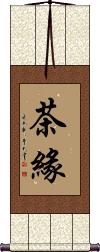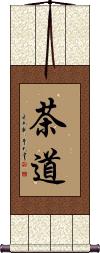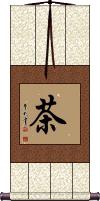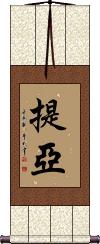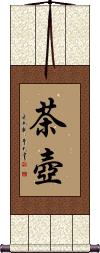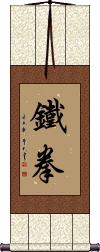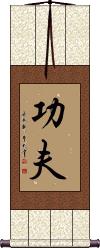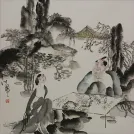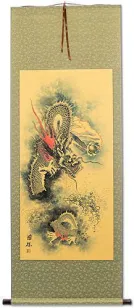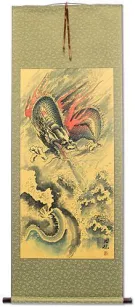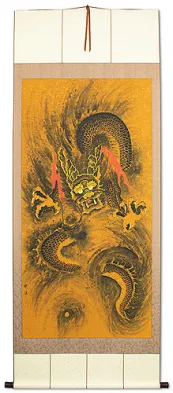Many custom options...
And formats...

Chinese Tea in Chinese...
Buy a Chinese Tea calligraphy wall scroll here!
Personalize your custom “Chinese Tea” project by clicking the button next to your favorite “Chinese Tea” title below...
Tea Fate
茶緣 is a special title for the tea lover. This kind of means “tea fate,” but it's more spiritual and hard to define. Perhaps the tea brought you in to drink it. Perhaps the tea will bring you and another tea-lover together. Perhaps you were already there, and the tea came to you. Perhaps it's the ah-ha moment you will have when drinking the tea.
I've been told not to explain this further, as it will either dilute or confuse the purposefully-ambiguous idea embedded in this enigma.
I happen to be the owner of a piece of calligraphy written by either the son or nephew of the last emperor of China, which is the title he wrote. It was given to me at a Beijing tea house in 2001. 茶緣 is where I learned to love tea after literally spending weeks tasting and studying everything I could about Chinese tea. I did not understand the significance of the authorship or the meaning of the title at all. Some 10 years later, I realized the gift was so profound and had such providence. Only now do I realize the value of a gift that it is too late to give proper thanks for. It was also years later that I ended up in this business and could have the artwork properly mounted as a wall scroll. It has been borrowed for many exhibitions and shows and always amazes native Chinese and Taiwanese who read the signature. This piece of calligraphy I once thought was just a bit of ink on a thin and wrinkled piece of paper, is now one of my most valued possessions. And fate has taught me to be more thankful for seemingly simple gifts.
The Way of Tea
茶道 means The Way of Tea (literally, “tea way”) in Chinese and Japanese.
This may refer to a tea ceremony or a general lifestyle of tea preparation and drinking.
In Japanese, this can be pronounced sadō or chadō (seems that sadō refers more often to a tea ceremony, and chadō when it's the Way of Tea).
茶道 is also used in the Buddhist context with the same meaning as the Way of Tea.
茶 means tea. It can refer to prepared tea (ready-to-drink) or dry tea leaves.
The origin of tea is China but the same character is used in Japanese Kanji, and old Korean Hanja with the exact same meaning. Japanese and Korean even borrowed the pronunciation from Chinese (pronounced “cha” in all three languages).
It's said that an early doctor (or herbologist) in ancient China kept poisoning himself as he tried different new herb concoctions. He invented tea as a means to detoxify himself as he recovered from 1 of the 76 times he nearly poisoned himself to death. Tea is seen not just as a drink but as a form of medicine used to remove impurities from the body.
The word “chai” (used in many languages to refer to various teas) is derived from this Chinese word.
茶 also means camellia, as Asian teas are often based on the leaves of camellia plant varieties.
Tea Pot
Iron Fist
Tie Quan / Tieh Chuan
鐵拳 is a common theme used by various schools of martial arts.
鐵 means “iron” but, in some cases, can mean “indisputable.”
拳 means fist.
Some schools use the older/Taiwanese way to Romanize the iron fist, so you may have seen it spelled “Tieh Chuan” instead of “Tie Quan.” Neither way is technically incorrect.
Note that in Mandarin, the first part of the first character sounds like the English word “tea,” blending into a soft “-eh” sound. The second character sounds a lot like “chew on” but as if it is one syllable.
![]() After WWII in Japan, the Kanji for iron was simplified. This new Kanji form is shown to the right. If you want this modern Japanese version, please click on the Kanji to the right, instead of the button above. The characters shown to the left would still be considered the old or ancient Japanese version of this title.
After WWII in Japan, the Kanji for iron was simplified. This new Kanji form is shown to the right. If you want this modern Japanese version, please click on the Kanji to the right, instead of the button above. The characters shown to the left would still be considered the old or ancient Japanese version of this title.
Kung Fu / Gong Fu
功夫 or Kung Fu is one of the most famous types of martial arts in the world - and not just because of Bruce Lee.
Some translate the meaning as “Accomplishment by Great Effort.” I think this is partially true, but directly translated, it literally means “Merit/Achievement/Accomplishment Man.” The word “fu” can sometimes mean “husband” or “porter,” but in this case, it can only mean “man.” However, few in China will think “man” when they hear the word “Gong Fu” spoken.
This term is also used for things other than martial arts. In fact, it's used to refer to a person with excellent skills in crafts that require a lot of effort to master, such as cooking, tea ceremonies, and calligraphy.
What a lot of people don't know is that the spelling of “Kung Fu” was actually taken from the old Wade Giles form of Romanization. Using this method, the sounds of the English “G” and “K” were both written as “K” and an apostrophe after the “K” told you it was supposed to sound like a “G.” Nobody in the west knew this rule, so most people pronounce it with a “K-sound.” And so, Gong Fu will always be Kung Fu for most westerners.
Also, just to educate you a little more, the “O” in “Gong” has a sound like the English word “oh.”
The popular Chinese dish “Kung Pao Chicken” suffers from the same problem. It should actually be “Gong Bao Chicken.”
Historical note: Many will claim that Kung Fu was invented by the monks of the Shaolin monastery. This fact is argued in both directions by scholars of Chinese history. Perhaps it is more accurate to say that the Shaolin Monks brought the original fame to Kung Fu many generations ago.
Japanese note: While most Japanese martial artists will recognize these characters, Katakana is more often used to approximate the pronunciation of "Kung Fu" with "カンフー." Some will argue as to whether this should be considered a Japanese word at all.
See Also: Bruce Lee
This in-stock artwork might be what you are looking for, and ships right away...
Decorative Chinese Tea Philosophy Painting
Discounted Blemished
Gallery Price: $61.00
Your Price: $33.88
Gallery Price: $60.00
Your Price: $36.88
Gallery Price: $61.00
Your Price: $33.88
Gallery Price: $178.00
Your Price: $98.88
Gallery Price: $240.00
Your Price: $138.88
Gallery Price: $240.00
Your Price: $138.88
Gallery Price: $240.00
Your Price: $148.88
Not the results for chinese tea that you were looking for?
Below are some entries from our dictionary that may match your chinese tea search...
| Characters If shown, 2nd row is Simp. Chinese |
Pronunciation Romanization |
Simple Dictionary Definition |
棗 枣 see styles |
zǎo zao3 tsao natsume なつめ |
(bound form) jujube; Chinese date (Zizyphus jujuba) (1) (kana only) jujube (Ziziphus jujuba); Chinese date; red date; (2) small tea caddy (tea ceremony); (surname, female given name) Natsume |
天目 see styles |
tenmoku てんもく |
(1) tenmoku; ceramics (esp. tea bowls) with a dark glaze that resembles oil spotting; (2) (abbreviation) (See 天目茶碗) tenmoku tea-bowl; dark-glazed conical tea-bowl of Chinese origin; (place-name, surname) Tenmoku |
涼茶 凉茶 see styles |
liáng chá liang2 cha2 liang ch`a liang cha |
Chinese herb tea |
珠茶 see styles |
zhū chá zhu1 cha2 chu ch`a chu cha |
gunpowder tea, Chinese green tea whose leaves are each formed into a small pellet |
甜茶 see styles |
tencha; tencha てんちゃ; テンチャ |
(1) {food} tian cha; sweet tea; blackberry leaf tea; (2) (kana only) {bot} Chinese blackberry (Rubus suavissimus) |
陸羽 陆羽 see styles |
lù yǔ lu4 yu3 lu yü rikuu / riku りくう |
Lu Yu (733-804), Chinese writer from Tang dynasty, known for his obsession with tea (person) Luk (Lu) Yu |
黒茶 see styles |
kurocha; kokucha くろちゃ; こくちゃ |
(noun - becomes adjective with の) (1) (くろちゃ only) (See 黒茶色) deep brown; (2) dark tea (e.g. Chinese pu'er tea); fermented tea |
中国茶 see styles |
chuugokucha / chugokucha ちゅうごくちゃ |
Chinese tea |
煎茶道 see styles |
senchadou / senchado せんちゃどう |
(See 煎茶・せんちゃ・1,黄檗宗・おうばくしゅう) sencha tea ceremony; Way of Sencha Tea; Chinese-influenced Japanese tea ceremony using leaf tea rather than powdered tea, assoc. with the Ōbaku school of zen |
紅茶茸 see styles |
kouchakinoko / kochakinoko こうちゃきのこ |
kombucha; drink of northern Chinese origin made by fermentation of sweetened tea |
紅茶菌 红茶菌 see styles |
hóng chá jun hong2 cha2 jun1 hung ch`a chün hung cha chün kouchakinoko / kochakinoko こうちゃきのこ |
kombucha (fermented tea) kombucha; drink of northern Chinese origin made by fermentation of sweetened tea |
釜炒茶 see styles |
kamairicha かまいりちゃ |
green tea fired in hot pans after a short withering (common Chinese technique) |
テンチャ see styles |
tencha テンチャ |
(1) (food term) tian cha; sweet tea; blackberry leaf tea; (2) (bot) (kana only) Chinese blackberry (Rubus suavissimus) |
天目茶碗 see styles |
tenmokujawan てんもくぢゃわん |
Tenmoku tea-bowl; dark-glazed conical tea-bowl of Chinese origin |
釜炒り茶 see styles |
kamairicha かまいりちゃ |
green tea fired in hot pans after a short withering (common Chinese technique) |
紅茶きのこ see styles |
kouchakinoko / kochakinoko こうちゃきのこ |
kombucha; drink of northern Chinese origin made by fermentation of sweetened tea |
Variations: |
hichuncha ひちゅんちゃ |
hyson (Chinese green tea) |
Variations: |
kamairicha かまいりちゃ |
green tea fired in hot pans after a short withering (common Chinese technique) |
Variations: |
tenmokujawan てんもくぢゃわん |
tenmoku tea-bowl; dark-glazed conical tea-bowl of Chinese origin |
Variations: |
kouchakinoko(紅茶kinoko); kouchakinoko(紅茶kinoko, 紅茶茸, 紅茶菌) / kochakinoko(紅茶kinoko); kochakinoko(紅茶kinoko, 紅茶茸, 紅茶菌) こうちゃキノコ(紅茶キノコ); こうちゃきのこ(紅茶きのこ, 紅茶茸, 紅茶菌) |
(not related to 昆布茶) kombucha; drink of northern Chinese origin made by fermentation of sweetened tea |
The following table may be helpful for those studying Chinese or Japanese...
| Title | Characters | Romaji (Romanized Japanese) | Various forms of Romanized Chinese | |
| Tea Fate | 茶緣 茶缘 | chá yuán / cha2 yuan2 / cha yuan / chayuan | ch`a yüan / chayüan / cha yüan | |
| The Way of Tea | 茶道 | cha dou / chadou / cha do | chá dào / cha2 dao4 / cha dao / chadao | ch`a tao / chatao / cha tao |
| Tea | 茶 | cha | chá / cha2 / cha | ch`a / cha |
| Tea | 提亞 提亚 | tí yà / ti2 ya4 / ti ya / tiya | t`i ya / tiya / ti ya | |
| Tea Pot | 茶壺 茶壶 | cha tsubo / chatsubo | chá hú / cha2 hu2 / cha hu / chahu | ch`a hu / chahu / cha hu |
| Iron Fist | 鐵拳 铁拳 / 鉄拳 | tekken / teken | tiě quán / tie3 quan2 / tie quan / tiequan | t`ieh ch`üan / tiehchüan / tieh chüan |
| Kung Fu Gong Fu | 功夫 | kan fu / ku fu kanfu / kufu | gōng fu / gong1 fu / gong fu / gongfu | kung fu / kungfu |
| In some entries above you will see that characters have different versions above and below a line. In these cases, the characters above the line are Traditional Chinese, while the ones below are Simplified Chinese. | ||||
Successful Chinese Character and Japanese Kanji calligraphy searches within the last few hours...
